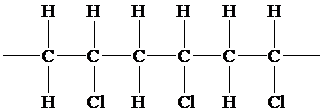
Concept explainers
Interpretation:
The Lewis structure of vinyl chloride, repeating units of vinyl chloride, and the enthalpy change are to be calculated.
Concept Introduction:
The standard enthalpy for a reaction is the amount of enthalpy change that occurs to occur understandard conditions(room temperature and pressure)
The enthalpy of reaction can be calculated as:
Here, BE represents the average value of bond enthalpy.
Answer to Problem 124AP
Solution:
(a)

(b)

(c)
Explanation of Solution
a)The Lewis structure of vinyl chloride
There are a total of 18 electrons in
The skeletal structure for

The Lewis structure for

b)Draw a portion of the molecule showing three
The poly vinyl chloride has the repeating chain of
The portion of poly vinyl chloride for three repeating chain of

Given information:
Mass,
c) The enthalpy change when
The molar mass of vinyl chloride is
The moles of vinyl chloride can be calculated as:
Substitute
The enthalpy of reaction can be calculated as:
From table 8.6, the enthalpy of formation values are:
Now, the standard enthalpy of a given reaction is:
Substitute,
The heat released is
Substitute
Hence, the enthalpy change is
Want to see more full solutions like this?
Chapter 8 Solutions
Chemistry
- What is the correct chemical equation for the lattice formation reaction for CaBr2? Group of answer choices Ca2+(g) + 2 Br−(g) → CaBr2(s) ½ Ca2+(g) + Br−(g) → ½ CaBr2(s) Ca(s) + Br2(l) → CaBr2(s) Ca(s) + 2 Br−(g) → CaBr2(s)arrow_forwardPLEASE ANSWER THE QUESTION!!!arrow_forward3. SYNTHESIS. Propose a sequence of synthetic steps (FGI) that convert the starting material (SM) into the Target molecule. For each FGI in your proposed synthesis, specify the reagents / conditions, and draw the product(s) of that FGI. DO NOT INCLUDE the FGI mxn in the answer you submit. If an FGI requires two reagent sets, specify the order in which the reagent sets are added, e.g., i) Hg(OAc)2 / H₂O; ii) NaBH4/MeOH. Indicate the stereochemistry (if any) of the products of each FGI. FGI 1. Me Starting Material Source of all carbons in the Target molecule (can use multiple copies) Me Me Target molecule + enantiomerarrow_forward
- curved arrows are used to illustate the flow of electrons. Using the provided starting and product structures, draw the curved electron-pushing arrows for the following reaction mechanism stepsarrow_forwardIf is was a very hot day, what would the aldol condensation product be? *see imagearrow_forwardPlease help me with number 1-3. Thank you so much.arrow_forward
- Draw the major product of this reaction ingnore the inorganic byproducts. 1. NaOCH2CH3 at 25 C 2. PhCH2Br (1 eq)arrow_forwardAt 90ºC the vapor pressure of ortho-xylene is 20 kPa and that of meta-xylene is 18 kPa. What is the composition of the vapor in equilibrium with a mixture in which the mole fraction of o-xylene is 0.60?arrow_forwardDraw the products of this reduction of a ketone with sodium borohydride. Use a dash or wedge bond to indicate the stereochemistry of substituents on asymmetric centers, where applicableIgnore any inorganic byproducts. 1) NaBH4 2) HCI/H2O Select to Drawarrow_forward
- Why do you think people who live at high altitudes are advised to add salt to water when boiling food like pasta? What mole fraction of NaCl is needed to raise the boiling point of H2O by 3˚C? Does the amount of salt added to water (typically about one teaspoon to four quarts of water) substantially change the boiling point? (Kb (H2O) = 0.51˚C/molal.)arrow_forwardpls help asaparrow_forwardpls help asaparrow_forward
 Chemistry: Principles and PracticeChemistryISBN:9780534420123Author:Daniel L. Reger, Scott R. Goode, David W. Ball, Edward MercerPublisher:Cengage Learning
Chemistry: Principles and PracticeChemistryISBN:9780534420123Author:Daniel L. Reger, Scott R. Goode, David W. Ball, Edward MercerPublisher:Cengage Learning
